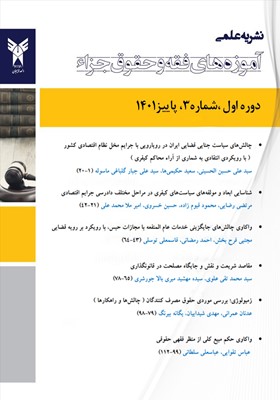زمیولوژی؛ بررسی موردی حقوق مصرفکنندگان (چالشها و راهکارها)
محورهای موضوعی : آموزه های فقه و حقوق جزاء
عدنان عمرانی فر
1
![]() ,
مهدی شیداییان
2
*
,
یگانه بیرنگ
3
,
مهدی شیداییان
2
*
,
یگانه بیرنگ
3
1 - دانشجوی دکترای حقوق جزاء و جرمشناسی، دانشگاه تهران، تهران، ایران
2 - استادیار گروه حقوق جزاء و جرمشناسی، دانشگاه تهران، تهران، ایران
3 - دانشجوی ارشد حقوق جزاء و جرمشناسی، واحد تهران جنوب، دانشگاه آزاد اسلامی، تهران،ایران
کلید واژه: مکتب زمیولوژی, جرمشناسی رادیکال, آسیبشناسی پدیده مجرمانه, ماورای جرم,
چکیده مقاله :
زمیولوژی مکتب نوپایی است که از دل جرمشناسی انقلابی ظهور کرده است و رسالت خود را به جای تکیه به مفهوم مضیق جرم، بر آسیب شناسی اجتماعی پدیدههای مجرمانه در مفهوم موسع، قرار داده است. اکنون مسأله اصلی، این است که آیا مکتب زمیولوژی میتواند با رویکرد آسیب اجتماعی شناسی، آسیبهای حقوق مصرفکننده را رکن اصیل بازار اقتصادی، شناسایی و راهکار ارائه دهد؟ نگارندگان معتقد هستند با پیچیده شدن آسیبهای وارده بر حقوق مصرفکنندگان، آموزههای زمیولوژی میتواند چالشهای مفهوم جرم را با آموزه هایی همچون: بررسی گستردگی آسیب، ورود پنهانی آسیب، فاصله طولانی از ایجاد تا ظهور، بیاطلاعی از قربانی شدن، دشواریِ قابلیت انتساب برطرف سازد. این پژوهش با روش توصیفی تحلیلی به این نتیجه میرسد که آموزههای زمیولوژی میتواند نارساییهای حقوق مصرف را در جهت حمایت با ارائه راهکارها و آسیبشناسی اقتصادی، جسمی روانی و آسیبشناسی اخلاقی را در جامعه پوشش دهد.
Zemiology is a nascent school that emerged from the heart of the revolutionary criminology and it has based it’s mission on the social pathology of criminal phenomena in the broader concept instead of reliance on the narrow concept of crime. Now, the main issue is that whether the school of zemiology with social pathology approach can identify and present a solution to the damages of the consumer’s rights as an original foundation of the economical market? The writers believe that with the complexities of the damages caused to the rights of consumers, the teachings of the zemiology can remove the challenges of the concept of crime with instructions such as; Examining the extension of the damage, the hidden entry of the damage, the long distance from creation to appearance,the ignorance of victimization, and the difficulty of assignability. This research with a descriptive-analytical method comes to the conclusion that the teachings of zemiology can cover the inadequacies of the consumer’s rights in the direction of supporting by presenting solutions and economical pathology, physical-psychological and moral pathology in the society.
الف: منابع فارسی
ب: منابع لاتین
_||_

